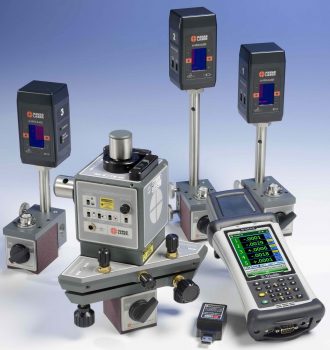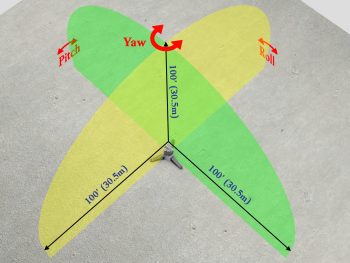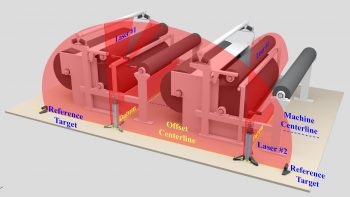L-742 Ultra-Precision Dual Scan® Laser
Hamar Laser’s L-742 Ultra-Precision Dual Scan® Laser Alignment System is designed for quickly and accurately aligning roll-forming and other machinery with rolls, as well as several other similar applications. Our Ultra-Precision Series L-742 and Precision Series L-732 are the only alignment systems in the world to offer 2 automatically rotating laser planes with the extreme high accuracy needed for today’s ever-tightening tolerances. They can be configured by the factory to have either 2 vertical laser planes (the typical configuration for roll alignment) or 1 horizontal and 1 vertical laser plane (for measuring flatness, straightness and squareness of surfaces and lower-accuracy machine axes). This creates a powerful tool that not only measures surface flatness, squareness and straightness, but also fixes complex alignment problems in a fraction of the time needed with conventional methods.
System Highlights
- Fast: Aligns roll-forming machinery and other roll alignment applications up to 70% faster than traditional methods.
- Easy: Multiple high-resolution wireless targets with a range of up to 100 ft provide live alignment data, so alignment errors can be fixed without changing the setup.
- Accurate: Ultra-precise laser planes have a flatness of 0.5 arc second (.00003 in/ft or 0.0025 mm/m) in a 360º sweep and 0.25 arc second (.000015 in/ft or 0.001 mm/m) in a 90º sweep.
- Versatile: Depending on the laser plane configuration, the system is ideal for virtually all roll machinery; plus machining centers, gantries, roll forming machines and many other applications.
- Smart: Powerful Windows-based alignment software, combined with advanced wireless interfaces, makes collecting and analyzing alignment data fast and easy.
Key Features
- 2 continuously rotating laser planes with operational range of 100 ft (30.5 m) in radius with 2 configurations:
- 2 vertical laser planes, typically used in roll alignment; and
- 1 vertical and 1 horizontal laser plane, typically used for machine-tool axis (or surface) flatness, straightness and squareness.
- Backlit levels accurate to 3 arc seconds (.00018 in/ft or 0.015mm/m). Upgrade to Split-Prism level vials for accuracy to .00006 in/ft (0.005 mm/m).
- Laser planes flat to 0.5 arc second (.00003 in/ft or 0.0025 mm/m) in 180º sweep and 0.25 arc second (.000015 in/ft or 0.001 mm/m) in 90º sweep.
- Planes are mutually square up to 1 arc second (.00006 in/ft or 0.005 mm/m).
- Standard targets: A-1519-2.4ZB Single-Axis Wireless Targets with 1 in. (25.4 mm) measuring range and .00002 in. (0.0005 mm) resolution.
- Optional high-accuracy targets: A-1520-2.4ZB Single-Axis Wireless Targets with .39 in. (10 mm) measuring range and .00001 in. (0.00025mm) resolution.
- For roll alignment system configuration, factory-built benchmark fixtures and laser translation slide are included in system.
- Includes Pitch/Roll/Yaw base with coarse and fine adjustments.
- Battery or AC powered.
- Typical setup time is 15 minutes or less.
If you do not see your application listed, please contact us to discuss your requirements. We will be more than happy to provide a solution that’s right for your unique alignment problem.
Applications
- Aircraft Interior Alignment (Storage Bins, Galleys, etc.)
- Floor Beam Alignment
- Jig/Tooling Calibration and Leveling
- Seat-Track Alignment
- Laser-Cutting Machines
- Routers
- Saw Mills
- Tube-Bending Machines
- Water-Jet Machines
- Woodworking Machines
- Agricultural Machinery Assembly
- Large Construction Machinery Assembly
- Locomotive Assembly
- Truck Bed Assembly
Leveling
- Machine Bed Leveling
- Split Joints on Steam Turbines
- Floor and Spar Mills
- Gantries
- Horizontal and Vertical Boring Mills
- Horizontal and Vertical Machining Centers
- Large-Lathe Beds
- Machine Tool Assembly and Calibration
- Roll-Forming Machines
- Transfer-Line Wing Bases
- Vertical and Horizontal Presses
- Vertical-Turning Lathes
- Blown-Film Lines
- Film Lines
- Injection Molding Machines
Quality Control
- Calibration of Large Fixtures
- Large-Part Flatness, Straightness and Squareness
- Scraping Machine Rolls
- Surface Plate Calibration
- Aluminum Mills
- Continuous Casting Machines
- Paper Mills
- Printing Presses
- Steel Mills
- Textile Mills
Ship Building
- Gun Bearing Alignment
- LNG Tanker Hull Construction
- Section Alignment and Layout
L-742 Ultra-Precision Dual Scan® Laser Alignment
Designed primarily for roll alignment and other similar applications, the L-742 Dual Scan® Laser System is the only laser in the world to offer 2 automatically rotating laser planes that are accurate enough for today’s ever-tightening tolerances. The laser can be configured by the factory to have either 2 vertical planes, or 1 horizontal and 1 vertical laser plane. This creates a powerful tool to not only MEASURE but also FIX problems in a fraction of the time needed with conventional methods.
Unsurpassed Plane Flatness
One of the critical components of any laser system is the straightness or flatness of the laser beam or plane, as this is the reference from which the measurements are made.
The L-742 features the flattest laser plane in the world. Its continuously rotating laser plane is flat to 1/2 an arc second (0.00003 in/ft or 0.002 mm/m) in a 360º sweep and 1/4 arcsec in a 90º sweep (0.000015 in/ft or 0.001 mm/m).
100' Squareness Measuring Capability
The 2 laser planes are square to within 1 arc second (0.00006 in/ft or 0.005 mm/m). This squareness can be projected out 100′ (30.5 M), allowing squareness of even the tallest machine in the world to be easily checked. The L-742 also features 2 built-in level vials that are accurate to 1 arc second.
Two Configurations for Many Different Applications
With two continuously sweeping, ultra-flat, orthogonal laser planes, the L-742 Dual Scan® Laser System is ideally suited for a whole host of alignment applications. The L-742 comes in 2 configurations. The standard L-742 has 1 horizontal laser plane and 1 vertical laser plane. It is used for measuring flatness straightness and squareness on machining centers, gantries and roll forming machines. The L-742WW has 2 vertical laser planes and is used primarily for aligning the horizontal roll parallelism of printing presses, paper mills, films lines and other roll alignment applications.
New Line of Wireless Targets
Another critical component of laser alignment systems is the resolution of the targets. This determines how close the measurements can be made.
The L-742 system utilizes our new line of wireless targets (A-1519-2.4ZB and A-1520-2.4ZB), there is no need to string long extension cords to reference targets. The targets have up to a 1 in. measuring range, a resolution as low as 0.00001 in. (0.00025 mm) and can be used up to 100 feet (30.5 meters) from the readout. The R-1357-2.4ZB Readout uses a PDA, which can simultaneously display up to 4 targets.
These targets are all powered by rechargeable batteries, are lightweight and can be used as digital height gages when used with precision inserts. And like all Hamar Laser systems, the targets provide live alignment data so misalignment errors can be fixed without changing the setup!
Applications
For applications with tolerances of 0.00002 in/ft or 0.0017 mm/m or higher, the L-742 can quickly measure and correct alignment errors with minimal setup for the following applications:
- Roll parallelism in:
- Paper mills,
- Printing presses
- Film lines
- Roll forming machines
- High-precision, laser and water-jet cutting machines
- Circuit board drilling machines
- Leveling almost any surface (squares, frames, ways, flanges, circles, etc.)
- Measuring and aligning:
- The flatness and straightness of almost any surface (squares, frames, ways, flanges, circles, etc.)
- The squareness of any 2 surfaces
- The flatness and straightness of vertical surfaces
- The flatness and straightness of horizontally and vertically traversing axes
- The parallelism of vertical or horizontal surfaces, even if those surfaces are 100 feet (30.5 meters apart)
- Checking plumb of a vertical surface up to 100 feet (30.5 meters)
- Checking way twist and parallelism between surfaces
- Measuring surfaces up to 200 feet (61 meters) long with 1 setup.
Geometry Analysis Software
For wireless recording and analyzing alignment data, our color, 3-D flatness and squareness analysis software, Plane5, simplifies and streamlines the data analysis process. It can measure up to 7 different surfaces in one project setup file and present a color, 3-D graph of the flatness and squareness analysis for each surface.
Our Machine Tool Geometry Software is also very useful for measuring and analyzing the lines of motion of machine tools. The user can select the type of machine tool to be analyzed and the software displays the top, side and front views of the machine. After collecting the data, the report shows flatness, straightness, parallelism and squareness errors on an easy-to-read report.
Downloads
- L-742 Roll Alignment Brochure – Rev E1
- A-1519-1520 Data Format – Type II – Programmer’s note -1 or 2-axis targets
- A1519 RS485 Cable Connection Diagram – Rev B
- L-106 Datasheet – Rev F
- R-1307B Basic Readout Datasheet -with KS – Rev F2
- R-1358-2.4XBE PDA Android Data Display – Rev A4
- S-1388 Plane5 Software Version II – Rev A
- S-1388 Plane5 Software Sample Report – Square
- S-1387 Machine Geo Software – Rev C
- Machine Geo Sample Report
- S-1405 Read15 PDA Software – Rev A
- Call Us: +1-203-730-4600
- Email: sales@hamarlaser.com
- Website: www.hamarlaser.com
- L-700 Lathe Alignment System
- L-702SP 5-Axis Machine Tool & Spindle Alignment System
- L-703 Bore, Spindle & Straightness Laser Alignment Systems
- L-705 Bore Alignment Laser System
- L-706 Bore Laser System
- L-706 Small-Bore Alignment Laser System
- L-708 Internal Bore Laser Systems
- L-730 Precision Leveling Laser
- L-732 Precision Dual Scan® Laser




